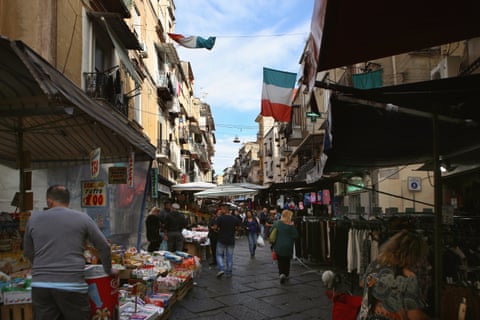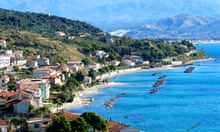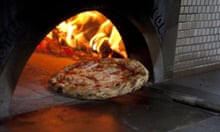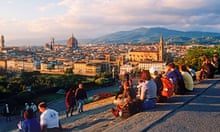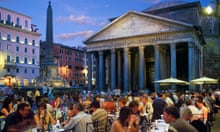Lenù and Lila, the fictional protagonists of Elena Ferrante’s Neapolitan novels, forge their friendship in a deprived area of Naples, just east of the cacophonous central station. The books follow the girls’ fraught relationship as they navigate the distinct social and economic divides of the city, both railing against and succumbing to the expectations of women as they struggle to be defined by something other than the violence and poverty of their post-war upbringing.
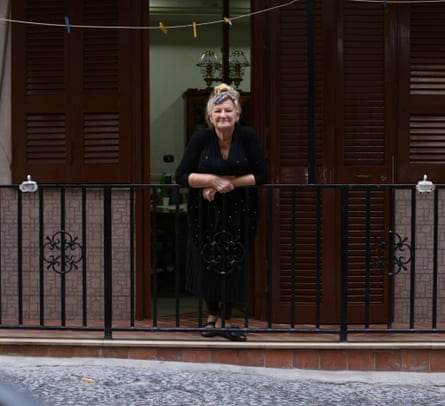
- A ground-floor apartment in a working class area of Naples.
Ferrante maps out in vivid detail every corner of the unnamed “neighbourhood” where they grow up, yet when the characters move into the rest of the city she is meticulous in naming each street and square, allowing Naples to take centre stage as the stories develop. In this way, the success of the novels has seen an unprecedented number of readers from across the world make a pilgrimage to Naples, in search of the raw and gritty side of the city that has traditionally kept visitors away.
The area where the girls grow up is based on working class Rione Luzzatti, which has hardly changed since the 1950s and does seemingly little to defy the city’s much-maligned reputation as a crumbling rogue governed by intimidating forces. However, those intent on discovering the stomping ground of the brilliant heroines will need to abandon preconceptions, ignore warnings of lawless, unruly Neapolitans, and head deep into the underbelly, to the city’s scarcely explored areas. It is here that the idiosyncrasies and contradictions of the city reveal themselves, and the real magic of Naples is to be discovered.

- Porta Capuana is one of Naples’ old city gates, built by the Aragonese dynasty and dating back to 1484.
To follow in the footsteps of characters in the four novels, head out of the historic centre on a Dante-esque trip into the Neapolitan underworld. Pass through the vast Aragonese city gates of Porta Capuana, now sitting alone in a square off Via Carbonara, and head into the pulsating heart of O’ Buvero street market.

- Naples street markets are a place to experience the energy of the city.
O’ Buvero is a human jumble of activity weaving through the decaying 15th-century palaces of Via Sant’Antonio Abate. It is here that the energy of the city’s street life can truly be experienced, resonating through the neighbourhood and into the cramped flats and echoing stairwells.




As you walk through the alleyways, it is impossible not to project the community of characters described in the book on to the market sellers. Stop to buy a bunch of tiny piennolo tomatoes from the equivalent of the Ada Cappuccio character who ran the fruit stall in Ferrante’s Naples, or watch as an Enzo Scanno equivalent loads crates of produce, like Jenga blocks, on to his cart to take back and sell in the neighbourhood.
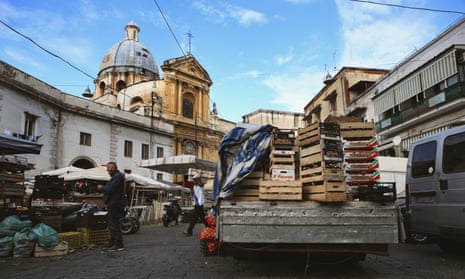
- A view of the church of Sant’Antonio Abate from behind the market.
If you were wondering where to find intimidating Solara brother types, striking illicit deals, look out for the men manning blackmarket cigarette stalls, their cartons neatly arranged on tablecloths so that they can be removed in one quick motion at the sight of police.

Deeper into the market, lurid insults filter from above, hurled from window to window by women as they lace the streets with laundry, just like Melina and Lidia squabbling over Donato Sarratore in the first book, My Brilliant Friend. Deals are thrashed out in thick Neapolitan dialect, while Vespas arrive loaded with boxes of broccoli-like friarelli, grown on the slopes of Vesuvius. Through a half-open door you may spot an old boy painting the colourful price tags that decorate the market stalls. Nearby may be a woman leaning out of her street-level apartment, cigarette in hand, waiting for a lighter to be lowered by rope in a basket from a floor above.
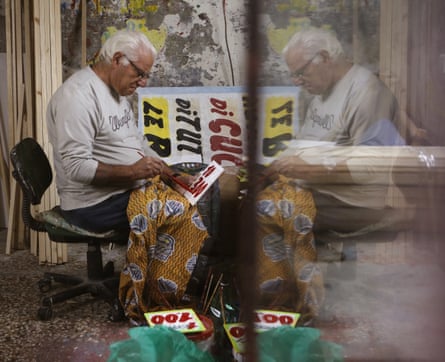
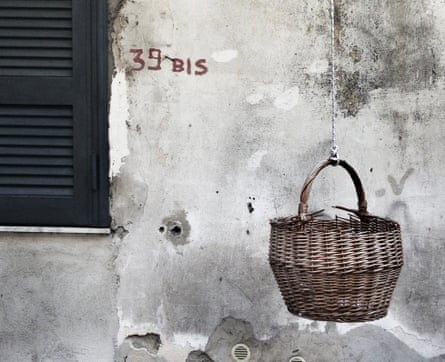
- Old world charm: Pasquale’s family has been making price tags for the markets across Naples for three generations. Right; passing a light with a basket.
Exiting the market, up Via Benedetto Cairoli to Corso Garibaldi, you pass a traditional acquafrescaio kiosk, selling sulphuric Telese from Vesuvius, known for its healing and aphrodisiac properties. Perhaps Elena Greco was under the influence of this potent volcanic liquid when she first laid her lustful eyes on the womaniser Nino Sarratore at the nearby high school.

- The infamous ‘stradone’, south-west of the Rione Luzzatti neighbourhood.
Take a taxi down the wide Via Taddeo da Sessa – the stradone of the books – with the financial district on the left, and leave behind the market and enter a seemingly less hospitable corner of the city, Rione Luzzatti. Silent women stare out of the barred windows of apartments in the four-storey Fascist-era housing blocks. The flats face on to shared courtyards, lined with grates into basements like the one where Lila threw Lenù’s doll, Tina. Occasionally, the stillness is punctured by schoolchildren tumbling out of the concrete elementary school on Via Marino Freccia for lunch, or the fishmonger whistling down the vacant avenues in his three-wheeled Piaggio.

- Telese mineral water on sale at the acquafrescaio kiosk on the corner of the market.

- Children run home after school. The elementary school Lenù and Lila would have attended is on the left and the parish church is behind them.
It’s worth spending some time exploring, however, as there are a number of reputable establishments around the central square. The basement Pasticciello bakery (Via Vesuvio 3C) has been attracting outsiders to the neighbourhood long before Ferrante’s books came out. It is famous for pagnutiello, a typical Neapolitan street snack made from eggs, ham and cheese, baked in crunchy bread and sold for €1. Signor Spagnuolo – Gigliola’s father – would have baked these as a warm lunch for workmen at the nearby central station.

- Il Pasticciello bakery, Rione Luzzatti. Below: Lucia and her assistant cracking eggs in the kitchen.

Down an espresso at Bar Pariso (Via Beato Leonardo Murialdo, on the corner of Piazza Francesco Coppola ), alongside men who, according to Ferrante, spend their time “between gambling losses and troublesome drunkness”. Try a vino sfuso – local aglianico wine dispensed straight from the barrel in a plastic cup – from Marco’s slither of a shop next to the tobacconists on Via Buonocore. Wander through the public gardens where Lila would have taught Elena her Latin verbs and past the Sacra Famiglia parish church, originally built in central Naples in the 15th century before being transported to the rione brick by brick, when the area needed a place of worship.

- Il Bar Pariso on the corner of the neighbourhood square.
If the bakery’s pagnutiello has your mouth watering, follow the stradone out of the neighbourhood and through the dark, infamous “tunnel with its three entrances” on Via Gianturco where Lila and Lenù skip school and first attempt to leave the neighbourhood to go and see the sea.
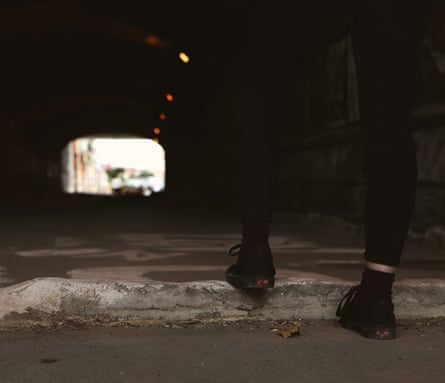
- The infamous tunnel on Via Gianturco, where Lila and Elena first attempt to leave the neighbourhood.
Turn right into the slighly more upmarket Case Nuove district for lunch at Pizzeria Carmnella. The pizzaiolo, Vincenzo Esposito, has invented a pizza to celebrate Elena Ferrante, mirroring the dishes served at a traditional Neapolitan Sunday lunch: ragú simmered for 24 hours, ricotta, fiordilatte mozzarella from Agerola on the Amalfi peninsula, grated parmesan and fresh basil.

- Pizzeria Carmnella: pizza margherita straight from the woodburning oven.


Not all of Ferrante’s bildungsroman is based in poor neighbourhoods. The life of Elena Greco reaches into the privileged pockets of Via Tasso and the Chiaia district too (as well as to Florence and Milan). Her books expose the Manichean elements of the city, the contrast of lightness and darkness, poverty and wealth, opportunity and hopelessness. So when, after lunch, you hurl across the city in a taxi to where the Solaras sold Lila’s shoes in an upmarket boutique in Piazza Dei Martiri, it feels like crossing a border, moving through tangible social and economic divides.
Ferrante’s characters are astonished by the stark contrast in daily life for richer folk, the orderly manner of things compared with the menacing chaos of the impoverished neighbourhoods. Lenù’s impressions of the Chiaia residents is that they “seemed to have breathed another air, to have eaten other food, to have dressed on some other planet, to have learned to walk on wisps of air”. The change in atmosphere is tangible under the central marble column surrounded by sculpted lions, in the square lined with elegant shops.

Follow the line of boutiques up to the top of Via Chiaia and the lavish Gambrinus coffee house on the corner of Piazza Trento e Trieste, where (unlike Ferrante) writers such as Hemingway and Neruda could afford to watch the world go by. As you pass by the familiar chain stores and well-heeled gentry, beware: a longing may set in for the raw and pulsating Naples to the east.

- Gambrinus Coffeehouse has been in Piazza Trieste e Trento since 1860, and has always been a meeting point for intellectuals, and for musicians performing in the San Carlo Opera House opposite.
As the writing in the Neapolitan novels attests, Naples is a city of vivid contradictions that summon conflicting emotions of love, loathing, shock and wonder. Searching for Lila Cerullo, the missing protagonist, in the less wealthy areas of the city means encountering Neapolitans who will go out of their way to disprove any negative reputation with the sort of warm, sociable and humble spirit associated with having always felt like the underdog. On the flip side, one can’t but be suspicious of invisible dark forces at play, nepotism and raging inequality. Wandering through the market and into the streets where Lenù and Lila’s friendship blossomed, and crisscrossing the city’s starkly divided neighbourhoods, is like reading the book itself: charged, consuming, and liable to start a lifelong love affair.
Sophia Seymour is a Naples based documentary maker, writer and the founder of Looking for Lila. She curates tours, shoots and events using the Ferrante novels as a frame to explore the city
